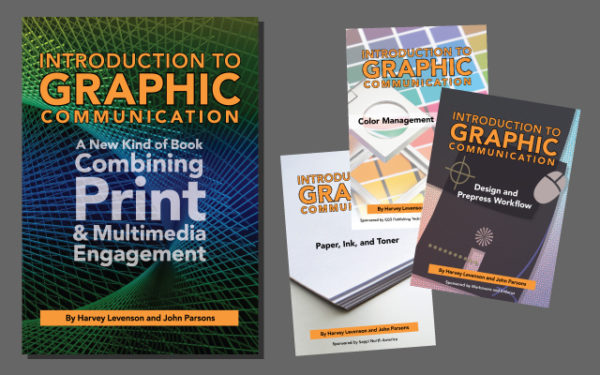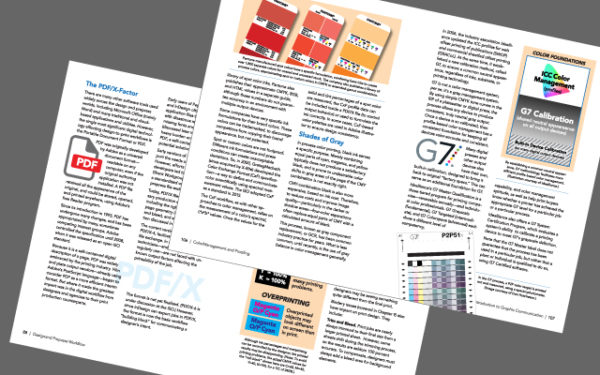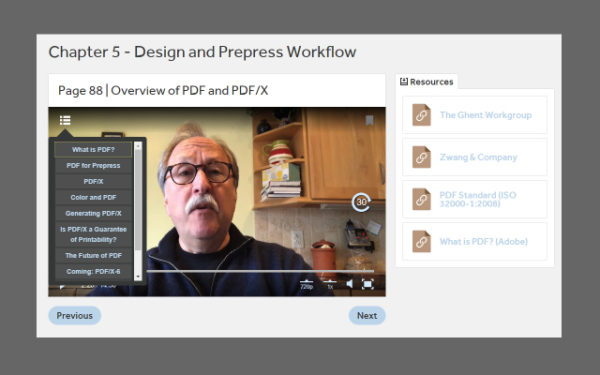New Edition of Introduction to Graphic Communication Merges Print with Augmented Reality
By John Parsons
In 2007, Cal Poly professor Harvey Levenson authored a textbook, Introduction to Graphic Communication. Published by PIA/GATF for those new to the peculiar world of print, it sold moderately well. However, like all books on technology, it rapidly became outdated. Colleges and training groups began asking for a new version.
A decade later, Harvey and I decided to create just that—but with a twist. Accompanying the book’s written content, we began to curate related video content and develop ways for readers to access it online—along with other resources and interactive venues. To connect the printed book with its augmented reality counterpart, we partnered with Ricoh, whose Clickable Paper technology far surpassed other “print-to-Web” mechanisms like QR Codes. This month, after countless hours of writing and production, the new book was released.

The new edition of Introduction to Graphic Communication will be followed by the publication of selected chapter booklets, for programs creating customized curricula.
Our rationale for this hybrid media approach is best summarized by Dr. David Eagleman, in his lecture series on The Neuroscience of Touch. It turns out that a preference for print is not just the bias of old guys like me. It is based on haptic principles—our sense of touch. A printed book, it turns out, is a better vehicle for meaningful engagement and knowledge retention. But we could not deny the value of online access—to supplement and enhance the core learning experience, and to connect the reader with ever-changing, practical information.
The first step was to make the book itself a reliable source of core concepts—one that the reader would want to keep close at hand. The fact that we could point readers directly to online videos and supplemental resources was liberating. We could focus on keeping the writing simple and direct, knowing that details of new or evolving technology could be added after publication.

Each chapter became the starting point for a much larger area of knowledge.
The online content posed its own challenges. Initially, we imagined that every page of the book could be scanned with the free Clickable Paper app, giving the reader immediate access to the videos and resources related to that page. In 2017, we printed a two-chapter prototype using that model. However, testing revealed that readers did not want to grab their mobile device to scan every page, even though the technology allowed it. So instead, we decided to make the opening spread of each chapter scannable—and let the reader navigate through all the material for that chapter at their convenience.
The videos themselves—of widely varying quality and duration—had to be edited, permissions secured, and made accessible in a way that benefitted the student. Hosting was also a problem. YouTube, although free to use, was a minefield of distraction and intrusion. So, we decided to use a secure, interactive video portal—Viddler.
The Viddler architecture offered more than security. Their player allowed us to add in-video navigation for longer videos, and external links to related websites and other supplemental material. For logged-in users, it even lets us add in-video questions, and record student video responses to class assignments.

Videos connected to the book include demos and talks by industry experts, as well as marketing videos (clearly labeled as such) that shed light on a particular process.
Clearly, we have only started to discover the potential of linking print and online media. Our original audience—students in print-related college and vocational programs—has expanded to include designers and print buyers, as well as new hires within printing companies. To the interactive video component, we have added access to an open LinkedIn group and a Slack channel, but clearly there will be more. Some have suggested podcasts and links to third-party LMS and training systems. What began as “just a book” is looking more like a vocation.
What began as Harvey’s and my love of printing has exploded into something more. Not every book will benefit from this hybrid approach, but certainly some will. A printed, touchable, hopefully well-written and well-designed book—with a practical mobile connection—may prove to be a reliable anchor in the chaotic ocean of online information.
***
John Parsons ([email protected]) is co-author, with Dr. Harvey Levenson, of Introduction to Graphic Communication (www.igcbook.com). A Seattle-area writer and consultant, John was formerly the Editorial Director of The Seybold Report.




I checked out the site and Amazon, and for 145 dollars I think I will pass this up as a source of information. And that does not include shipping. We need to be creating cost-effective materials.